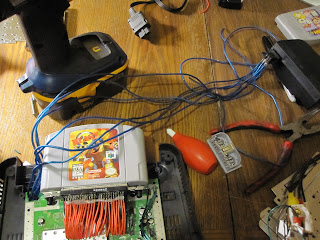This is the view looking up through the bottom of the toaster. At this point everything worked.
This is the top and bottom of the toaster, connected, and ready to be put together and finish the project. I tested the system here and encountered a million problems.
First: I kept shorting out my power adapters. I ended up taking out the LEDs and it really helped, but still had a problem later. At this point I have not yet solved this issue.
Second: The video stopped working. It took me a long time, but i found that one of the wires on the catridge slot (that row of 25 wires) snapped off. Of course it was in the hardest spot to work with.
Third: The game booted, but i had no visual and crackling sound. My video connection on the motherboard snapped, and my grounds for my audio were loose.
Fourth, and the biggest issue: My player 1 controller was not recognizing the joystick. Basically that meant you couldn't move around in any games. If this was an issue in any other port, meaning player 2, 3, or 4, I would have ignored it. However, the whole reason for this is so Lauren can play these 2 specific games. I tried replacing the wires, solder points, controller ports, controllers, and nothing. It turns out that a REALLY tiny filter capacitor on the underside of the motherboard got scratched or dislodged. The solution would be to go straight to the source (pictured below)...
Chipt U8 is in essence the brain of the controllers. I attached the pinout below for anyone who is curious. Each controller has a communication, power, and ground. So I needed to connect wires to the P1 Data, Ground, and 3.3V. I took a picture with a quarter so you can see how ridiculously tiny these solder points are.
At these point I've burned myself in every way possible. Today I decided to use my fingernail to tighten a screw. For some reason I dismissed the fact that the screw was 900 degrees :(























